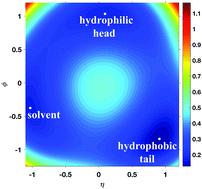当前位置:
X-MOL 学术
›
Soft Matter
›
论文详情
Our official English website, www.x-mol.net, welcomes your feedback! (Note: you will need to create a separate account there.)
Pathways connecting two opposed bilayers with a fusion pore: a molecularly-informed phase field approach.
Soft Matter ( IF 3.4 ) Pub Date : 2019-11-19 , DOI: 10.1039/c9sm01983a Yucen Han 1 , Zirui Xu , An-Chang Shi , Lei Zhang
Soft Matter ( IF 3.4 ) Pub Date : 2019-11-19 , DOI: 10.1039/c9sm01983a Yucen Han 1 , Zirui Xu , An-Chang Shi , Lei Zhang
Affiliation

|
A phase field model with two phase fields, representing the concentration and the head–tail separation of amphiphilic molecules, respectively, has been constructed using an extension of the Ohta–Kawasaki model (Macromolecules, 1986, 19, 2621–2632). It is shown that this molecularly-informed phase field model is capable of producing various self-assembled amphiphilic aggregates, such as bilayers, vesicles and micelles. Furthermore, pathways connecting two opposed bilayers with a fusion pore are obtained by using a combination of the phase field model and the string method. Multiple fusion pathways, including a classical pathway and a leaky pathway, have been obtained depending on the initial separation of the two bilayers. The study shed light on the understanding of the membrane fusion pathways and, more importantly, laid a foundation for further investigation of more complex membrane morphologies and transitions.
中文翻译:

将两个相对的双层与一个融合孔相连的途径:一种分子信息学的相场方法。
A相场模型具有两个阶段字段,代表浓度和两亲分子的头-尾分离,分别,一直用太田崎模型(的延伸部构成的Macromolecules,1986年,19,2621–2632)。结果表明,这种分子信息化的相场模型能够产生各种自组装的两亲性聚集体,例如双层,囊泡和胶束。此外,通过使用相场模型和弦方法的组合,获得了将两个相对的双层与一个融合孔连接起来的途径。取决于两个双层的初始分离,已经获得了多种融合途径,包括经典途径和渗漏途径。该研究为了解膜融合途径提供了基础,更重要的是,它为进一步研究更复杂的膜形态和转变奠定了基础。
更新日期:2019-11-19
中文翻译:

将两个相对的双层与一个融合孔相连的途径:一种分子信息学的相场方法。
A相场模型具有两个阶段字段,代表浓度和两亲分子的头-尾分离,分别,一直用太田崎模型(的延伸部构成的Macromolecules,1986年,19,2621–2632)。结果表明,这种分子信息化的相场模型能够产生各种自组装的两亲性聚集体,例如双层,囊泡和胶束。此外,通过使用相场模型和弦方法的组合,获得了将两个相对的双层与一个融合孔连接起来的途径。取决于两个双层的初始分离,已经获得了多种融合途径,包括经典途径和渗漏途径。该研究为了解膜融合途径提供了基础,更重要的是,它为进一步研究更复杂的膜形态和转变奠定了基础。


























 京公网安备 11010802027423号
京公网安备 11010802027423号